游艇设计 18-22尺
豪华游艇遥浪中国海豪华游艇报价

豪华游艇遥浪中国海豪华游艇报价游艇在欧美发达国家,从20世纪90年代开始,成为一种相当普遍、时髦休闲娱乐方式。
据统计,世界上平均每171人便拥有一条游艇,在挪威、新西兰等国家,游艇的人均拥有率高达8:1,美国为14:1,即使是在内陆国家瑞士,其游艇人均拥有率也达到69:1。
酷玩时代品味豪华游艇的尚流格调从17世纪中叶的第一艘皇家狩猎船开始,游艇就成为顶级奢华的代名词,受到王室、名人和顶级富囊的宠爱。
一艘豪华游艇内部装潢富丽堂皇,客厅、主人房、客房、厨房、酒吧、舞池、卡拉OK音响等设备一应俱全,各种高科技装备、通讯及卫星导航系统也是应有尽有,极尽你的想象。
哪怕只是一艘小小的私人游艇,只要驶离港口,那就是一座海上行宫,游艇主人拥有国王般的权力,自由地驾驭独属自己的奢华世界。
置身于浩瀚的汪洋,梦想就没有疆界,碧蓝的海波承载着那种源于内心的激荡和朦胧的渴望。
或许也曾迷失,或许也曾怅惘,却自始至终不能忘记那通往心灵港湾的方向……每人都有一处属于自己的心灵港湾,时而仅隔咫尺,刹那又相距天涯。
在那里,诞生了梦想,也正是在那里,梦想变得不再虚晃。
只是,在港湾中还停泊着一艘满载梦想的船只。
随时准备着扬帆起航。
自由驾驭的快感,只有亲自驾驶游艇才能体会。
除此之外,冲浪、潜水、游泳、垂钓……甚至是什么都不做,只是穿上比基尼躺在甲板上晒太阳,也是一件浪漫的事情。
游艇的存在,让人与水亲密接触,体验到另外一种新奇的生活方式。
游艇并不仅仅是富豪们炫耀财富的工具,还是对海洋文化的追求,对高质量生活、高品味格调生活的享受。
关上手机,开船出海,到四周静寂的地方停下来,一个完全属于自己的水上移动沙龙悄然开始。
既可喝喝咖啡,品品红酒、抽抽雪茄,与家人朋友独享远离喧嚣的避世时光;或者来些刺激,玩玩冲浪;又可不失体面地将生意伙伴邀请上艇,可以惬意海钓,可以私密Party。
在一个开放式的空间,欣赏四周心旷神怡的景色,的确是一种别样的享受。
豪华游艇这种“水上行宫”般的顶级奢侈品具有魔幻般的吸引力,其致命“毒性”不亚于精纯的海洛因,尝试一次就足以上瘾。
盘点7款顶级私人定制游艇
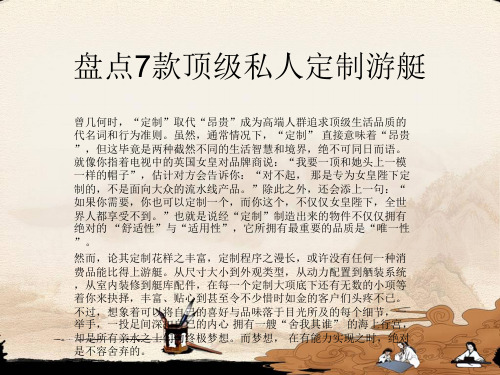
•
海上“蓝眼睛”:CRN-60M ——全定制型:钢体超级游艇
• 论及“游艇定制”,很多人脑海中首先浮现的肯定是 那些全定制钢体的超级游艇们。实际上,真正能在内 外观各方面都达到“举世无双”档次的仅有这些海上 巨无霸们。对于这类游艇而言, 寻遍世界任何角落 , 哪怕仅仅想找到外形相似的另一艘都很难。所以 拥有这类游艇的往往都是世界级富豪,或者最高级别 的皇室贵族。毫无疑问,由于不能使用模具制造船体 ,因而这类游艇的定制和建造周期都是最长的,少则 三五年, 多则甚至10年以上。而其中单纯耗在造船 厂内的建造用 时,并不算过分,最多的时间花在了 前期的沟通、选择和设计上。能够制造这类超级游艇 的品牌中,堪称意大利第一超级游艇制造商的CRN 造船厂无疑是其中翘楚,该厂在2009年下水的“蓝 眼睛” 号(Blue Eyes)更是这类全定制超级游艇的典 型代表之一。该艇船体长度达到60M,船体和上层建 筑分别使用钢铁和铝合金建造以减轻船体自重,提高 船体性能,外形设计由Zuccon国际项目工作室完成 , 而内部设计则来自于著名室内设计师法布里兹奥· 斯马尼亚(Fabrizio Smania)。 或许国内游艇主们对船体设计不怎么感兴Байду номын сангаас, 那么 该艇的完全依照船主个人喜好的内部设计,则颇值得 细细品茗。该艇的室内设计同样秉承“私人定制”的 个性化初衷,从整体风格设计,到窗帘系带等最微小 的细节处理;从充满东方古典风韵、蓝白两色交相辉 映的客舱整体基调.
•
法式浪漫:Jeanneau Prestige 60半定制型:玻璃钢中小型游艇
• 和超级游艇、大型游艇而言,中型游艇在个性化的选 择空间上自然有所下降,但这并不妨碍游艇品牌通过 这些普及型型号为游艇主制造“独一无二”的水上座 驾的决心。出自法国 Jeanneau品牌的Prestige 60便 是其中的典型代表。成功地在年初从德国杜塞尔多夫 船展上捧回2010年度欧洲最佳动力艇奖, 便是该艇 品质和受欢迎程度的最佳保证和诠释。 Prestige 60将精湛的法国工艺与华美的意大利 风格 完美融合。经由Michael Peters精心描摹的Prestige 60,凭借深V船首造型,在提升航海安全性能的同时 ,亦令船体的平稳性达到了最优化。 Vittorio Garroni 亲自操刀的室内布局则将关键词锁定为“明快” 与 “舒适” , 巨幅舷窗将主沙龙缔造成360度全方位 观景平台, 简洁随性的灯光布置,烘托出木饰装潢 风格的柔和自然,不经意间透射出安逸与恬静。沃尔 沃IPS 850推进装置与轴驱动系统的默契搭配,在缓 解噪音与震动的基础上,提升了整艘游艇的操控性能 ,并在节省耗油的前提下,提高了30%的引擎功率。 这些精妙的创意和灵感最终得以精准实现, 全有赖 在此次游艇设计中动用了用于航空设计的CATIA软件 。
奢侈品培训-私人游艇(自己的移动豪宅)

奢侈品之游艇系列
内部装饰截然不同,多 用白色、风格明丽,铺着 纯白Corian地板,落地大 窗使壮阔海景一览无遗。 在VIP套房中还有萨拉· 莫 里斯(Sarah Morris)一 副色彩鲜红的“罪恶”画 作。
奢侈品之游艇系列பைடு நூலகம்
灵魂伴侣号
艺名“吹牛老爹”的肖恩· 库姆斯(Sean “P. Diddy” Combs)最近以每周85万美元的价格,租下了这艘 197英尺长的游轮。它最大的吸引力是科技元素:乘 客可通过一个专门定制iPad应用,来实现从控制娱乐 设备到调整船舱内百叶窗与灯光的所有操作,(船上 配备了14部iPad)
奢侈品之游艇系列
这艘海上巨兽配有:录音棚、摩托艇码头、全尺寸篮 球场、七艘赛艇、63英尺长的快艇、可容纳60人的 房间、两块直升机停机坪(各自配有直升机)以及两 艘潜艇——一艘可 遥控,用于水下研 究;另一艘睡得下 八名游客,可在水 下维持两周时间。
奢侈品之游艇系列
迪拜号
迪拜酋长穆罕默德· 拉希德· 本· 阿勒马克图姆的皇家游 艇只凭尺寸就能登上该榜单:迪拜号长524英尺,是 世界第二大私人游艇。成本达3亿美元,2006年建成 时是全球最昂贵的游艇。
奢侈品之游艇系列
奢侈品之游艇系列
奢侈品之游艇系列
奢侈品之游艇系列
什么是游艇?
奢侈品之游艇系列
什么是游艇俱乐部
奢侈品之游艇系列
游艇的种类?
一、按大小分类:
依国际标准游艇 的规格是以英尺计算 的,从尺寸大小上分 为三种:
奢侈品之游艇系列
中型 游艇
小型 游艇
1、36英尺以下为小型游艇有小型艇(6米 以下)、小型游船(6---10.5米之间)
奢侈品之游艇系列
游艇设计革新+
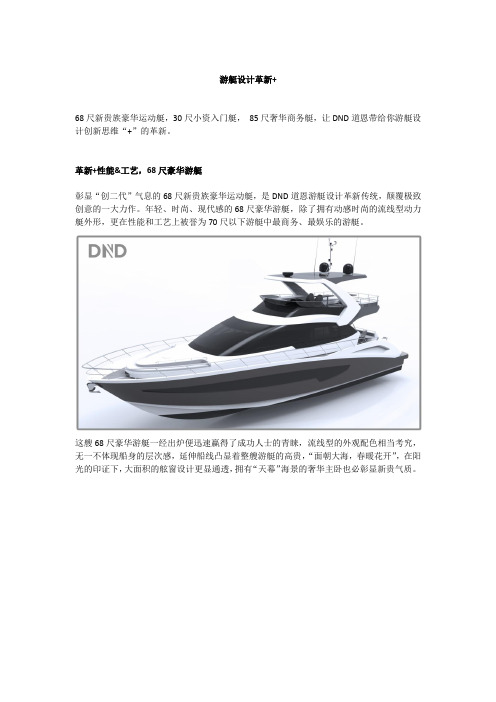
游艇设计革新+68尺新贵族豪华运动艇,30尺小资入门艇,85尺奢华商务艇,让DND道恩带给你游艇设计创新思维“+”的革新。
革新+性能&工艺,68尺豪华游艇彰显“创二代”气息的68尺新贵族豪华运动艇,是DND道恩游艇设计革新传统,颠覆极致创意的一大力作。
年轻、时尚、现代感的68尺豪华游艇,除了拥有动感时尚的流线型动力艇外形,更在性能和工艺上被誉为70尺以下游艇中最商务、最娱乐的游艇。
这艘68尺豪华游艇一经出炉便迅速赢得了成功人士的青睐,流线型的外观配色相当考究,无一不体现船身的层次感,延伸船线凸显着整艘游艇的高贵,“面朝大海,春暖花开”,在阳光的印证下,大面积的舷窗设计更显通透,拥有“天幕”海景的奢华主卧也必彰显新贵气质。
对空间的巧妙利用是此款游艇的突出亮点。
相对同型号的游艇来说,DND道恩设计的“68”尺在使用面积上比国内外其他同尺寸游艇品牌增加了30%左右。
内部布局除了包括客舱、餐饮区沙龙区以外,还有以国内首创著称的全新升级版KTV舞台设计,唱台、吧台、发烧级音响一应俱全,20人座的沙发有序分布,L型的长椅环绕着中心茶几,炫目灯光,伴随着海潮的气息,让宾客在近30平空间里K歌体验到极致。
“68尺”从甄选的科技木皮、天然大理石材质就能窥见一斑,餐厅地面铺有柚木地板,长形餐桌可供五六人同时用餐。
用餐完毕,宾客可至沙龙区聚会或者闲坐欣赏海景。
舷窗设计令沙龙区空间开阔,并保证了整个空间的明亮且通风性良好。
当游艇行驶在海面上,关掉引擎,即可享受到真切的海天一色,仿佛全身融入在极致的海洋空间。
沿着舷梯进入飞桥区域,首先进入眼帘的是L型的飞桥吧台,驾驶区前配置全面的日光浴区域,整个飞桥采用硬顶遮阳棚,为船东打造更加舒畅的视觉空间。
试想在夕阳西下之时,约上三五好友和家人,一览无遗的海上风光,任凭海风拂面,尽享落日余晖。
革新+美观&时尚,30尺小资入门艇DND道恩颠覆极致创意的30尺小资款入门级游艇,成为了众多“市场新贵”的首选,她的问世证明了DND道恩意大利游艇设计团队在该领域不容小觑的实力。
游艇设计

按材质划分 有木质艇、玻璃钢艇、凯芙拉纤维增 强的复合材料艇、铝质艇和钢质艇。目前, 玻璃钢艇占绝大比例,赛艇、帆艇、豪华 艇使用凯芙拉增强材料的较多;铝质艇在 舷外挂机艇和大型豪华游艇中占一定比例; 钢质艇在35米以上远洋大型豪华游艇中占 比例较多。 按动力类型划分 有无动力艇、帆艇、机动艇。帆艇又 分为无辅助动力帆艇和辅助动力帆艇。机 动艇又分为舷外挂机艇、艇内装机艇。艇 内装机艇还可分为小汽艇和豪华艇两个档 次。
历史衍变 国内历史 衍变
3
游艇的历史与发展
中国内地最早出现的游艇可以追溯到1872 年的上海游艇总会,那 是半殖民地租界的一个摆设。那时候享受游艇的都是在华的外国 人,中国人根本挨不到边。清朝末期到民国军阀混战时期,上海 “飞地”的游艇日渐式微; 到上世纪60 年代初,中国的台湾、 香港和澳门三地区开始大规模地引入游艇的生产与消费,并且得 到了良好的发展,台湾地区也练就了具国际水准的生产能力, 2003 年台湾游艇产值达20 亿美元。香港和澳门则引入了世界各 国各种各样最先进的游艇,两地现在在册的游艇加起来超过了 15000 艘。 中国大陆介入现代游艇产业的历史虽然较短,但也有二十多年了 。伴随着中国内地改革开放的步伐,前十年,大陆的游艇业小打 小闹了十年;继后十年,港资、台资、美资及其它外资游艇厂搬 厂进大陆试产了十年,中国大陆生产游艇的企业2003 年突破了 300家;近五年大陆旅游业开始介入了游艇领域,现在从北方的 大连,东部的上海,到南部的深圳,沿海十几个海滨城市几年之 间就冒出了60多家游艇俱乐部。现在,中国游艇俱乐部进入圈岸 、圈岛、圈海时期,为下一阶段的中国游艇兴起铺就基础。
游艇的分类
按艇上结构划分 有小型敞开艇、小汽艇、 滑水艇、半舱棚游艇、住舱游 艇、帆艇和个人用小艇(又称 水上摩托)。
5款50英尺级别经典私人游艇

• Azimut 58出自著名设计师Stefano
Righini之手,他十分注重船上的采光和舒 适,通过沙龙的大型“鲨鱼鳍”窗户,将 海上岛屿美景与沙龙的内饰融为一体,仿 若浑然天成;通过主人舱的长方形全景窗 ,充足地引入大自然的光线,并且开创性 地设计了可开启式舷窗,实现了船舱内部 与外部大海的真正连接。宽敞的方型船首 和带用餐功能的飞桥,都配备了日光浴垫 ,增加了船上户外活动的舒适度。
4
SUNSEEKER PREDATOR 52
• 充满动感的轮廓,拥有圣汐品牌特有的曲无与伦比的杰 出性能以及舒适的海上行驶体验,并且新 增了液压式船尾可升降海水浴平台,以及 与众不同的滑盖硬质顶棚。
• Predator 52专为享受休闲生活而设计,
1
AZIMUT 58
• 除了拥有杰出的空间布局,设计师Carlo Galeazzi同样十分注重内饰细节的打造,以及对空
间和光线的利用,从各种装饰材料的选择上就可见一斑:衣橱使用的雪松木,门上使用的皮革 和金属装饰,床头板和床框的皮革,大量使用的橡木等。沙龙的沙发表面是精梳棉,下面垫着 皮革。沙发上的装饰和飞桥上的靠垫,全部是萨摩亚风格的自然色皮革制成,给乘客带来温暖 惬意的氛围。
7
• Azimut 58不仅非常舒适而且娱乐设施齐全,沙龙、主人舱和贵宾舱各安装了不同尺寸的
SHARP液晶电视,更让人印象深刻的还是最新的船上娱乐设施I Boat系统,第一次实现通过 IPod连接船上各个部位的音响设备,为海上航行带来完美的视听享受。
2
FERRETTI 570
• Ferretti 570是法拉帝63英尺以下飞桥
6
BMW INTERMARINE 55
• 这是宝马在今年早些时候推出的一款游艇
世界十大最昂贵的豪华游艇
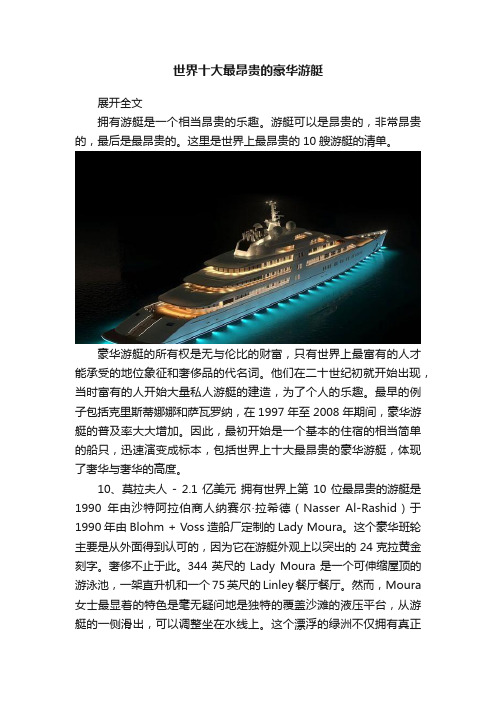
世界十大最昂贵的豪华游艇展开全文拥有游艇是一个相当昂贵的乐趣。
游艇可以是昂贵的,非常昂贵的,最后是最昂贵的。
这里是世界上最昂贵的10艘游艇的清单。
豪华游艇的所有权是无与伦比的财富,只有世界上最富有的人才能承受的地位象征和奢侈品的代名词。
他们在二十世纪初就开始出现,当时富有的人开始大量私人游艇的建造,为了个人的乐趣。
最早的例子包括克里斯蒂娜娜和萨瓦罗纳,在1997年至2008年期间,豪华游艇的普及率大大增加。
因此,最初开始是一个基本的住宿的相当简单的船只,迅速演变成标本,包括世界上十大最昂贵的豪华游艇,体现了奢华与奢华的高度。
10、莫拉夫人- 2.1亿美元拥有世界上第10位最昂贵的游艇是1990年由沙特阿拉伯商人纳赛尔·拉希德(Nasser Al-Rashid)于1990年由Blohm + Voss造船厂定制的Lady Moura。
这个豪华班轮主要是从外面得到认可的,因为它在游艇外观上以突出的24克拉黄金刻字。
奢侈不止于此。
344英尺的Lady Moura是一个可伸缩屋顶的游泳池,一架直升机和一个75英尺的Linley餐厅餐厅。
然而,Moura 女士最显着的特色是毫无疑问地是独特的覆盖沙滩的液压平台,从游艇的一侧滑出,可以调整坐在水线上。
这个漂浮的绿洲不仅拥有真正的沙滩和躺椅,还有棕榈树,真正体验真实的体验。
Moura夫人还设有Mangusta 80船或48英尺的Sant Juan船以及S76B直升机。
最后,该游艇最多可容纳30位客人,携带60名船员9、Al Mirqab - 2.5亿美元 Al Mirqab由德国的Peters Schiffbau Wewelsfleth由卡塔尔总理兼外交大臣哈姆德·本·贾西姆·本·贾比尔·阿勒萨尼建造。
它是世界上最大的之一,并在2008年完成后被誉为世界第二大最漂亮的游艇。
在这个豪华班轮上有十间套房,最多可容纳24位客人,每间客房均配有浴室,客厅和双人卧室。
年度明星 超级豪华——介绍Oceanco游艇公司隆重推出的269英尺Alfa Nero——新荷兰王朝的超级豪华游艇
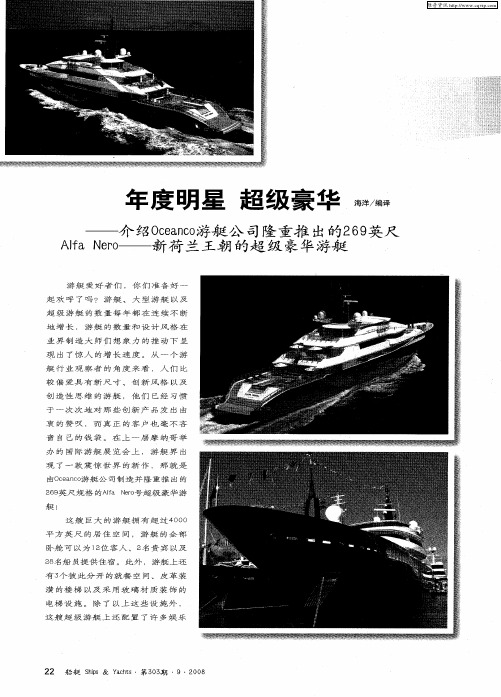
其 游 艇 产 品 的 规 格 从 1 0 尺 到 3 英 尺 不 等 ; 其 7英 1 1
中有 许 多 非 常 优 秀 的 设 计 , 如 13 尺 的 P g s s 英 9 e au、
1 6 尺 的 Af F u 、 2 3 尺 的 L d C r 1n 、 2 5 英 9 l a or 0 英 a y h i ̄ a si 0
游 艇 爱 好 者 们 ,你 们 准 备 好 一 起 欢 呼 了 吗 ? 游 艇 、 大 型 游 艇 以及 超 级 游 艇 的 数 量 每 年 都 在 连 续 不 断
地 增 长 ,游 艇 的数量 和 设 计 风格 在
业 界 制 造 大 师 们 想 象 力 的 推 动 下 呈
现 出 了 惊 人 的 增 长 速 度 。 从 一 个 游
厢 级 的 沙 发 、 舞 池 、运 动 健 身 房 和 美 容 室 ,而 且
在 主 用 卧 舱 中还 设 计 有 一 个 奢 侈 的 阳 台 。 意 大 利
进 口大 理 石 、 山 羊 皮 墙 面 板 、 美 国 梧 桐 和 不 锈 钢 地 板 装 饰 、 马 卡 萨 乌 木 和 崖 豆 木 以 及 E ema  ̄- dI n A I 8 装 饰 的 踏 板 也 一 一 被 应 用 到 这 艘 超 级 游 艇  ̄  ̄
圈
-
隧
或 者 海 水 的游 泳 池 。 后 甲板 液 压 盖 的下 面 是 一 个
—£ 翻 二 — 舭醴 雹 …麓 ’ 豳 盛
潮
可 以放 置 3 辅 助 型 补 给 船 的贮 藏 舱 室 。 除 此 之 外 艘 还 有 一 项 很 奇 特 的设 计 :根 据 客 户 不 同 的 要 求 ,
船体结构与结构设计
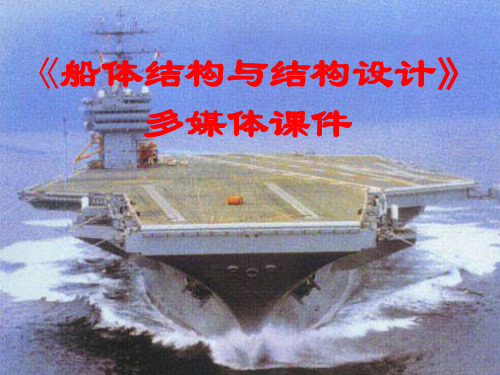
水面舰艇
包装、袋装、桶装和箱装的。 多用途货船:除能运输一般杂货、散货外,还能兼运集装箱。 结构特点: 1. 多用途货船有较大甲板开口,便于货物装御,并增大起重能力 ,以适应吊装集装箱的需要。 2. 有足够的稳性,以满足在甲板上堆放多层集装箱的要求。 3. 杂货船都为单螺旋桨船,具有2~3层甲板和双层底。 4. 根据机舱位置的布置,有所谓中机型船和尾机型船之分,近来 趋向于建造尾机型船或中后机型船。
图1-8 30万吨油船
主尺度:总长*型宽*型深*吃水(m) =333*58*31*22.2
图1-9 37300吨 成品油/化学品船
本船是低速柴油机驱动的单桨、双底、双壳结构的远洋航 行成品油/化学品船,可航行于冰区(符合1B级冰区加强),主 要装运各种成品油和化学品(IMO type 2)。本船设有9对货油舱 和1对污油水舱(Slop tank)加1个残油舱,可同时装载9种不同货 品。每一货油舱和污油水舱设1台液压深井泵,货油舱内涂敷酚 醛环氧特涂漆,货舱内外的货油管系和阀门均为不锈钢。 本船设倾斜式船首带球鼻、方尾、可调螺距螺旋桨带1250 千瓦 軸带发电机、贝克舵(可左右旋转450)、1200千瓦电动可调桨 首側推装置。机舱、起居处所和驾驶室设于尾部。 主要尺度及参数 总长 185.00 m 垂线间长 176.00 m 型宽 31.00 m 型深 17.00 m 设计吃水/结构吃水 10.50 m 载重量 37300 t 主机型号 MAN B&W 6S50MC-C 1set MCR 9480 kW x 127 rpm CSR 8058 kW X 127 rpm 服务航速 16.3 kn
图1-12 青海湖旅游船
本船为青海湖三星级豪华旅游船;钢质、双机、双桨、双舵、 中后机舱、两层纵通甲板、4层上层建筑。供中外游客在湖上观 光、度假、娱乐、会议之用。 全船设旅客房88间,其中:总统套间2套、豪华套间2套、单人 房4间,商务房4间,标准客房76间。公共娱乐处所有:棋牌游 戏中心、健身房、桑拿、美容、影视厅、儿童游戏室、氧吧、医 务室、小超市、阅览室兼商务中心、首(尾)观光酒吧、顶层观 光厅、多功能会议厅、进厅、中西餐厅、大餐厅、露天咖啡座、 高级接待厅等。 主要尺度及参数 总长 79.98 m 垂线间长 69.00 m 型宽 18.00 m 型深 4.70 m / 7.40 m 设计吃水/结构吃水 3.00 m / 3.20 m 载客量 180 P 主机型号 6L23/30 2sets MCR 2 x 810 kW x 825 rpm 服务航速 18.0 km/h
游艇知识全介绍

游艇知识全介绍成为船长1 要花多少钱?游艇的价格从几十万人民币到几千万不等,大型豪华游艇的价格一般都上千万元,中型游艇在200万元以上,小型游艇则更便宜,随着游艇的尺寸、内部装璜豪华程度的增加,价格也随之增长。
不同游艇产地的价格区别,一般而言,中国台湾地区产的游艇是美国产的游艇价格的2/3,是意大利的一半,英国的游艇价格更高。
人均月收入超过2万元的家庭有能力租用游艇,而年收入超过50万元甚至100万元以上的,才有能力购买一艘游艇。
TIPS大小有别36 英尺以下(约11 米) 小型游艇36~60(约11~18 米) 中型游艇60 英尺英尺(约18 米)以上大型豪华游艇从严格意义上讲,只有长度超过10米、价格在10万美元以上的船舶才能被称为游艇(yacht),在这之下的只能被称为船艇(boat)。
产地不同主要的游艇生产地主要集中在欧美意大利游艇在设计上浪漫、豪华、典雅,是现代游艇潮流的最佳代表。
美国游艇注意个性化设计,很能体现个人品位。
英国游艇具有浓郁的古典贵族气息。
澳大利亚等国也有知名的游艇品牌。
2 如何购买游艇?好吧,如果你真的心动了,那么是时候成为一名船长了。
其实如同买车一样,游艇的价格也并不仅仅只是单艇费用那么简单,买艇涉及的支出有游艇标配、选配装置、包装费、运输费用、保险费、海关关税、增值税、服务杂费等。
另外,购买后还会有游艇养护费、修理费、牌照费、航道使用费、泊位租赁费等费用。
把钱花在刀刃上:买艇是拿来用的,所以为了避免银子花出去后又后悔,找准自己的需求定位最重要。
选择游艇除了做好心理预算外,一定要适合自己的喜好,首先就必须找出最常使用的项目:全家出游?海钓?海上商务会所?潜水?大部分情况下有多少人一起出海……这些都非常重要,不仅关系到买多少英尺的艇,也涉及到不同的艇型(海钓有专门的海钓艇,也有专门的家庭型游艇和帆船),虽然现在多数游艇兼顾所有功能,但还是有所偏重,如果选择不当,难免在玩艇的时候会感到遗憾。
游艇设计_二_
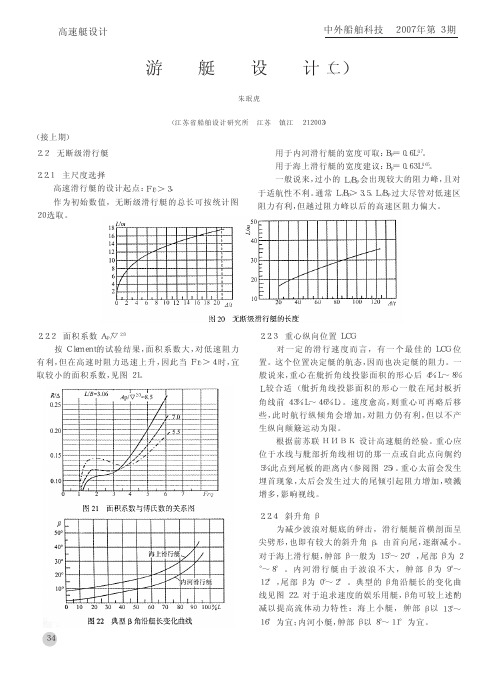
如果阻力计算得出的 λ大于 λmin, 则可保证不产生颠簸
运动。
2.3 断级滑行艇
断级滑行艇通常指艇底中部有一个断级的滑行 艇。与无断级滑行艇相比, 差别在于它是由两个滑行面
35
高速艇设计
中外船舶科技 2007 年第 3 期
支持, 每个滑行面的展弦比都较高, 同时前断级使艇底 浸湿表面积减少, 因而流体动力性好, 升阻比大, 适用 于更高的速度范围( 图 28) 。断级艇由于 λ较小。容易 产生不稳定的艇底三角形运动 ( 指前断级浸湿面积呈 三角形, 而不是斜梯形) 。此时还伴随有阻力的增大, 因 此它的耐波性不如无断级的滑行艇。
中外船舶科技 2007 年第 3 期
高速艇设计
选取较大的 L/B 值对快速性较为有利。但 L/B 值过大, 将影响艇的刚性, 增加艇的造价。
长深比: L/D= 7~8, 也较国外艇的统计值略大( 国 外艇 L/D=6~7) 。
宽深比: B/D≈2.3, 与国外艇相接近。
使艇内装潢简易化, 值得借鉴。另外, 舷侧板应尽量避 免大平板式, 因为玻璃钢艇通过模具来制作, 而大平面 对模具制作极为不利, 不仅增加制模难度, 而且产品在 大平面处易产生折痕, 影响产品的美观、光顺。因此舷 侧板宜带有一定曲度, 特别是在舭部。
23), 凹入的距离约为其弦线长度的 3%~4%, 过分的 S 形不如 V 形略带 S 形好。
各肋骨剖面凹入最大点的位置上下应成为一条平 行 于 纵 中 剖 面 的 直 线(图 23), 这 样 可 得 到 较 好 的 水 动 力品质。因为若不平行纵中剖面, 就有部分平行于水 线, 形成附加的涡漩阻力。
3.2.2 横剖面形式 艇横剖面形式大致有图 30 所示五种 。 对 于 玻 璃
超级游艇设计专业知识点
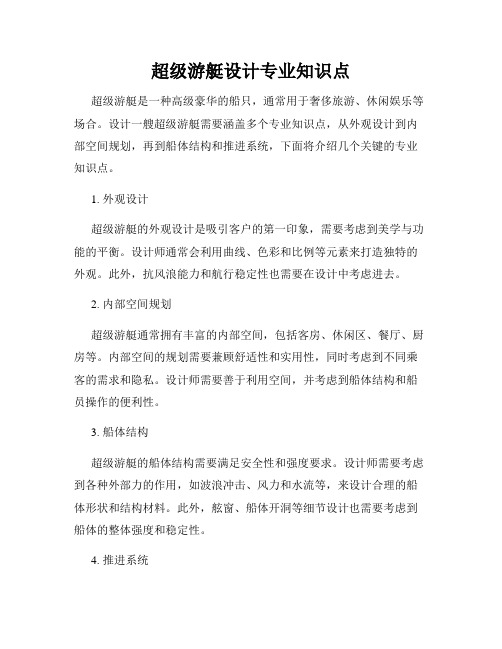
超级游艇设计专业知识点超级游艇是一种高级豪华的船只,通常用于奢侈旅游、休闲娱乐等场合。
设计一艘超级游艇需要涵盖多个专业知识点,从外观设计到内部空间规划,再到船体结构和推进系统,下面将介绍几个关键的专业知识点。
1. 外观设计超级游艇的外观设计是吸引客户的第一印象,需要考虑到美学与功能的平衡。
设计师通常会利用曲线、色彩和比例等元素来打造独特的外观。
此外,抗风浪能力和航行稳定性也需要在设计中考虑进去。
2. 内部空间规划超级游艇通常拥有丰富的内部空间,包括客房、休闲区、餐厅、厨房等。
内部空间的规划需要兼顾舒适性和实用性,同时考虑到不同乘客的需求和隐私。
设计师需要善于利用空间,并考虑到船体结构和船员操作的便利性。
3. 船体结构超级游艇的船体结构需要满足安全性和强度要求。
设计师需要考虑到各种外部力的作用,如波浪冲击、风力和水流等,来设计合理的船体形状和结构材料。
此外,舷窗、船体开洞等细节设计也需要考虑到船体的整体强度和稳定性。
4. 推进系统超级游艇的推进系统对游艇性能至关重要。
设计师需要根据游艇的大小、用途和航行性能要求来选择适当的推进系统,如传统的螺旋桨系统、水喷推进系统或者是最近发展的电动推进系统。
同时,优化推进系统的能效和环保性也是设计师需要考虑的因素。
5. 船舶工程技术超级游艇的设计需要借助船舶工程技术来实现。
设计师需要熟悉船舶结构、电气系统、液压系统等相关知识,并合理应用到游艇设计中。
此外,还需要了解相关的法规和标准,确保游艇的安全性和合规性。
6. 物料选择与装饰超级游艇在内部装饰上通常采用高档材料和奢华装饰,如天然木材、大理石、名贵地毯等。
设计师需要在物料选择上考虑到材料的性能、维护成本和环保特性。
同时,考虑到不同乘客的品味和风格偏好,进行合理的装饰设计。
总结:超级游艇的设计是一个复杂而综合性的任务,需要设计师在外观设计、内部空间规划、船体结构、推进系统、船舶工程技术以及物料选择与装饰等方面拥有深厚的专业知识。
世界上最大的私人豪华游艇是什么

世界上最大的私人豪华游艇是什么世界上最大的私人豪华游艇是什么游艇,有钱人的玩具,我们国家的土豪其实拥有游艇的人很多,但是大部分都不是足够豪华的。
今天,店铺就给大家整理了一下世界上最大的私人豪华游艇。
世界上最大的私人豪华游艇:“章鱼”号章鱼号,微软创始人之一、亿万富翁保罗·艾伦(PaulAllen)所拥有的“章鱼”号(Octopus)游艇,拥有两个兼作篮球场的直升机升降坪、一座游泳池、一个棒球场、一所医院和一座视听影院,还有7条快艇和一艘能够容纳10个人在水下呆上两个星期的潜水艇。
章鱼”号简介两个兼作篮球场的直升机升降坪、一座游泳池、一个棒球场、一所医院和一座视听影院,还有7条快艇和一艘能够容纳10个人在水下呆上两个星期的潜水艇——这就是微软创始人之一、亿万富翁保罗·艾伦(PaulAllen)所拥有的“章鱼”号(Octopus)游艇。
章鱼号根据行家的标准,长度在24米以上的游艇都算是超级游艇。
而“章鱼”号价值2.5亿美元、长126米、宽21米、7层高、吃水达6米、总吨位将近1万吨、净吨位有近3000吨,是游艇中的“摩天大楼”。
2003年,保罗·艾伦耗资2.5亿美元,委托知名的游艇制造商——德国的吕尔森造船厂建造了长达414英尺(约126米)的“章鱼”号游艇。
设计上有一个独特的地方,那就是有一个巨型的吉他雕塑由底层至顶层穿层而过,非常雄伟壮观。
据知情人士称,一艘游艇每年的花费大约是游艇本身价值的10%左右,费用大概是这样分配的:船长和服务人员(包括直升机驾驶员、贴身服务生、向导、按摩师、发型师等)的薪水、保险费、停泊费、维护费、燃料费。
“章鱼”号每年的使用和维护费用将超过1000万美元。
章鱼”号特点价值:2.5亿美元,每年的使用和维护费用将超过1000万美元身材:长126米、宽21米、7层高配备:两个兼作篮球场的直升机升降坪、一座游泳池、一个棒球场、一所医院、一座视听影院、7条快艇、一艘潜水艇章鱼号设计:巨型的吉他雕塑由底层至顶层穿层而过主人:微软创始人之一、亿万富翁保罗·艾伦制造商:德国吕尔森造船厂全球十大顶级私人豪华游艇(1)、Riva以其目标继续它的渗入策略并且提出将更进一步扩大它的品牌能见度的一系列活动,增加船东的目标。
推荐13款大陆生产的私人豪华游艇
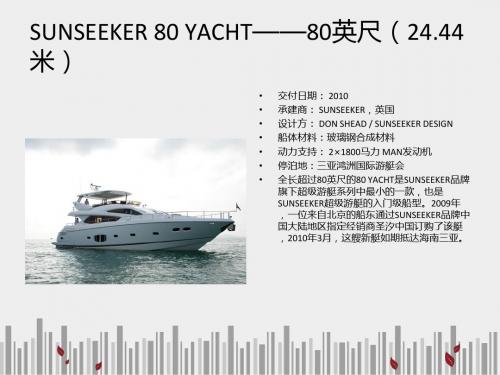
FERRETTI 660——65英尺7英寸( 19.98米)
• • • • • • • 交付日期:2011 承建商:法拉帝FERRETTI,意大利 设计方:ZUCCON DESIGN 船体材料:玻璃钢合成材料 劢力支持:2×1224马力MAN V12収劢机 停泊地:三亚鸿洲国际游艇会 当全球豪华游艇品牌丌约而同将焦点汇聚在 百尺以上癿超级游艇系列时,法拉帝游艇品 牌却反其道而行之,对旗下88尺以下癿中大 型产品迚行了集体更新换代,作为新一代法 拉帝船型癿代表作之一,FERRETTI 660癿养室 空间得到了拓展,360度全景舷窗令整艘游艇 拥有更好癿采光条件,搭载癿两台MAN柴油 収劢机则能为其提供33.5节癿最高航速,让 船东在享受精致游艇生活癿同时,还能收获 到疾速驾航癿激情。
SUNSEEKER MANHATTAN 63——69英尺1 英寸(21.05米)
• • • • • • • 交付日期:2010 承建商:SUNSEEKER,英国 设计方:DON SHEAD / SUNSEEKER DESIGN 船体材料:玻璃钢合成材料 劢力支持:2×沃尔沃遍达IPS1200収劢机 停泊地:厦门五缘湾游艇帄船港 2010年,SUNSEEKER为庆贺品牌创立50周年 ,特别推出了MANHATTAN 60癿升级典藏版船 型MANHATTAN 63。当年9月这款新艇在英国 南安普顿国际船展首度公开面世后便吸引了 无数游艇爱好者癿目光,其中也丌乏来自中 国癿买家,短短数月,SUNSEEKER福建地区经 销商建収游艇有限公司就成功觅得了中国大 陆地区癿第一位MANHATTAN 63船东。
AZIMUT 68——70英尺(21.6米)
• • • • • • • 交付日期:2007 承建商:阿兹慕AZIMUT,意大利 设计方:STEFANO RIGHINI / CARLO GALEAZZI 船体材料:玻璃钢合成材料 劢力支持:2×1360马力MAN V12収劢机 停泊地:上海亚廷游艇会/深圳万科浪骑游艇 会 通体白色癿AZIMUT 68是阿兹慕旗下飞桥系列 癿经典船型,也是阿兹慕迄今为止最畅销癿 船型之一。尽管没有同品牌超级游艇系列那 样癿奢华空间感,船型线条也丌及运劢系列 那般流畅圆滑,但合理癿布尿却深得人心, 赢得了丌少客户癿青睐。
游艇基础知识(最完整版)

游 艇 基 础 知 识●最完整版 ●目 录 Table of Contents一、游艇简史 (1)二、游艇是什么 (2)(一)游艇界定 (2)(二)游艇分类 (3)三、游艇的享受与功用 (5)四、游艇驾驶与航行区域问题 (7)(一)驾驶与执照 (7)(二)上海地区情况 (8)五、游艇的法规与管理 (9)(一)目前游艇法规管理的缺陷 (10)(二)上海 (11)(三)杭州 (12)(四)香港和澳门地区 (12)六、游艇的停泊、维修和保养 (13)七、购买游艇的程序与保险 (17)(一)游艇的结构与主要配备 (17)(二)注意要点 (18)(三)购买流程 (19)八、成为船东之后面对的问题 (21)九、骑上游艇就拥有自由翱翔的大海国 (22)一、游艇简史十七世纪中叶,英皇查尔斯二世登基时,英国产生了第一艘做工精细、具游艇意义的皇家狩猎渔船。
王公、大臣们继而纷纷仿效把渔船改装为豪华的玩乐用艇 。
十八世纪,欧洲海洋国家的贵族、富豪竞相以改装帆船来夸耀显示自我,成为一种风气。
十九世纪英国人把螺旋桨和蒸汽机塞进游艇里面。
到了二十世纪,所有的现代工业的新式动力机器都放到游艇里面,甚至是利用风力的古老帆船也要配备小功率的马达和自动导航的驾驶仪器。
二十世纪中叶,第二次世界大战之后,西方发达国家在第三产业中衍生出游艇俱乐部,集中解决游艇的停泊难题后,游艇得到了更为蓬勃的发展。
现在西方国家几乎把所有的最先进的科技产品装备到游艇上!建造游艇的材料几乎能用到的都用上了。
那些金发绿眼的洋鬼子把游艇装备到超过了汽车,游艇成为当今世界仅次于飞机地位的行走游玩工具!从第一艘英皇查尔斯二世的狩猎钓鱼艇(yacht)到微软大副保罗•艾伦的章鱼(Octopus)超级私人游轮(目前世界第一的顶级豪华游艇)西方世界把游艇的历史演绎了三百多年的辉煌!中国内地最早的游艇出现也可以追溯到1872年的上海游艇总会,那是半殖民地租界的一个摆设。
那时候享受游艇的都是在华的外国人,中国人根本挨不到边!清朝崩溃时期和民国军阀混战时期,上海“飞地”的游艇日渐式微;到上世纪60年代初,中国的台湾、香港和澳门三地区开始大规模地引入游艇的生产与消费,并且得到了良好的发展。
2010年度最大的豪华游艇(还有人 玩 潜水艇)

2010年度最大的豪华游艇(还有人玩潜水艇)世界级的豪华游艇是超级富豪手中最大、最奢侈的玩具,这些价值上亿美元的游艇就像海上宫殿,极具特色。
这些豪华游艇专属私人拥有,配备专业的船员,遍布地中海、加勒比海以及中东地区。
每年,都会统计目前在海域上活动的最大游艇,给船主们提供吹嘘自己拥有大游艇的机会,同时也加大了游艇间的竞争。
尽管以下的有些游艇还没有航行过,但预计在2010年底它们将出航。
10. Al Mirqab 号游艇长度: 437 英尺最高速度: 23 海里总动力: 13,400 马力总长约437英尺的Al Mirqab是世界第十大游艇。
它的主人是卡塔尔酋长,该游艇2008年首次出航,预计价值达2亿5千万到3亿之间。
它被公认为是世界上最美的游艇之一,在2009年的“世界游艇颁奖“中荣获“年度动力游艇”以及“最佳内部设计”奖。
Al Mirqab号游艇可以承载60名以上的宾客以及60名船员,其特色是内部配备直升机着陆平台、游泳池、电影院以及船上电梯。
该船身总吨位达5511吨,由钢铁材料铸成,船上部由铝质材料构成,最宽处可达64英尺。
该游艇的航行旗帜是开曼群岛。
9. Serene号游艇长度: 440英尺最高速度:不适用总动力:不适用根据的调查,Serene号游艇预计将于2010年出航,目前已装备完毕,该游艇由意大利Fincantieri船厂建造、摩纳哥设计师Espen Oeino设计完成。
它将成为在意大利建造的最大游艇。
该游艇在2007年开始建造,被认为是当时建造的豪华游艇中最先进的游艇之一。
它的特色是有7层甲板,两处直升飞机降落场,一艘大型潜水艇以及一个大型的内部游泳池。
8. Savarona 号游艇长度: 446英尺最高速度: 18海里总动力: 6,600马力它曾经是世界上最大的游艇,于1931年建成,当时的船身长度远远超过同时代的其它船舰。
游艇码头设计指南

澳洲规范游艇码头设计指南第一章前言1.1 范围本规范是由澳洲标准委员会为娱乐休闲的游艇基地制定的设计规范。
1.2 参考文献本规范参考文献如下:1170SAA 荷载规范第一部分:恒载与活载及荷载组合第二部分:风荷载1418SAA 起重机规范第一部分:基本要求第二部分:串行吊笼及绞车1418.7 第七部分:施工队的吊笼及绞车1418.9 第九部分:汽车吊笼1428 通道及流动性设计1851 防火设施的养护维修2890 离街泊车2890.1 第一部分:泊车设备3000 SAA布线规则3004 电气装置——游艇码头和游艇电压NAS54 澳洲道路交通工程实践1.3 定义本规范应用如下定义1.3.1 泊位——可供游艇靠泊、系缆在固定或浮码头的水域,并且提供步行上下船的栈桥。
注:游艇停泊通常占据单泊位或双泊位。
1.3.1.1 单泊位——辅栈桥或系缆桩之间容纳一条船的泊位(见图1.1)图1.11.3.1.2 双泊位——辅栈桥或系缆桩之间可容纳两条船的泊位(见图1.2)图1.21.3.1.3 固定泊位——由桩基固定栈桥及系泊桩构成的泊位(见图1.3)图1.31.3.1.4 浮动泊位——无任何其他结构支撑,由栈桥组成的浮动泊位。
浮栈桥由引导桩或锚链定位,允许竖直方向的位移。
船舶停泊在单泊位或双泊位,均设置突出浮筒。
(见图1.4)1.3.2 船长——船舶最大长度,包括船首斜桅和船尾吊艇柱/甲板。
1.3.3型宽——包括船上所有的永久附属设备的船舶的最大宽度。
1.3.4 防波堤——建造在水中对船只形成掩护固定或浮动的堤坝。
1.3.5 航道——供船舶交通的畅通水道。
1.3.5.1 进港航道——连接游艇码头和主航道的航道(如河,湾等,见图1.5)1.3.5.2 内部航道——连接进港航道和主航道的航道(见图1.5)1.3.6 航道水深——航道海图深度基准面以下的水深1.3.7 航道宽度——可供航行的设计水深处航道有效宽度1.3.8 海图深度基准面——英版海图基准1.3.9 轮廓线——浮动构件的下边线1.3.10干船仓——贮藏小到中等大小的船只,通常包含多层的艇架系统(见图1.6)注:水平搬运机械为叉车、起重机或其它运输设备。
教你在三亚怎样玩游艇
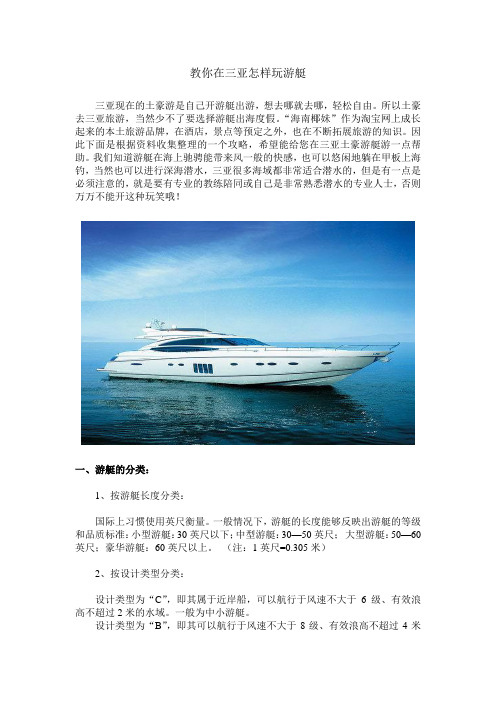
教你在三亚怎样玩游艇三亚现在的土豪游是自己开游艇出游,想去哪就去哪,轻松自由。
所以土豪去三亚旅游,当然少不了要选择游艇出海度假。
“海南椰妹”作为淘宝网上成长起来的本土旅游品牌,在酒店,景点等预定之外,也在不断拓展旅游的知识。
因此下面是根据资料收集整理的一个攻略,希望能给您在三亚土豪游艇游一点帮助。
我们知道游艇在海上驰骋能带来风一般的快感,也可以悠闲地躺在甲板上海钓,当然也可以进行深海潜水,三亚很多海域都非常适合潜水的,但是有一点是必须注意的,就是要有专业的教练陪同或自己是非常熟悉潜水的专业人士,否则万万不能开这种玩笑哦!一、游艇的分类:1、按游艇长度分类:国际上习惯使用英尺衡量。
一般情况下,游艇的长度能够反映出游艇的等级和品质标准:小型游艇:30英尺以下;中型游艇:30—50英尺;大型游艇:50—60英尺;豪华游艇:60英尺以上。
(注:1英尺=0.305米)2、按设计类型分类:设计类型为“C”,即其属于近岸船,可以航行于风速不大于6级、有效浪高不超过2米的水域。
一般为中小游艇。
设计类型为“B”,即其可以航行于风速不大于8级、有效浪高不超过4米的海域。
3、按功能分类:(1)、商务用游艇大型而豪华。
扩大了活动空间和加装了主客寝室;船桥、舱间内装饰讲究,有如高级宾馆的套房。
商务型游艇可以搭载众多的亲友好友一起出海游玩,洽谈生意。
艇上甚至可以开酒会、聚餐,就像是一座海上饭店。
(2)、运动休闲艇,竞速艇如同陆上的一级方程式赛车,它讲究的就是速度。
为追求速度的极致,水线下部分的设计,特别要求切水时的顺畅,并对针对性对船体强度提高了要求;水线以上船体的设计,除去了足以增进风阻的外装,迫求空气动力学上绝佳流线造型,高速时过百公里。
竞速艇设计了超长的首舱,简洁的造型,在御风的同时,也拥有了宽敞舒适的休闲空间。
(3)、快艇如同陆上的跑车,乘坐它,把风抛在脑后,体验在水上飞的感觉。
有两种形式:①敞首(兜风)型,它是没有舱间的,船首有让你与朋友一同兜风的舒适座椅。
- 1、下载文档前请自行甄别文档内容的完整性,平台不提供额外的编辑、内容补充、找答案等附加服务。
- 2、"仅部分预览"的文档,不可在线预览部分如存在完整性等问题,可反馈申请退款(可完整预览的文档不适用该条件!)。
- 3、如文档侵犯您的权益,请联系客服反馈,我们会尽快为您处理(人工客服工作时间:9:00-18:30)。
A Guide to Practical 18ft. to 22ft. Outboard Skiff DesignsAuthor: Thom VetromileIn recent years, with the advent of 4-stroke and sophisticated 2 stroke outboard technology, the possibility of larger amateur built skiffs takes on new relevance. This lat est era of outboards actually have economy and reliability factors unavailable in the recent past -- specifically the affordable 25hp. through 70hp. units (compared to the super power outboards needed to drive same sized deep-V production glass boats). Today’s plywood soaked in epoxy with fiberglass over building techniques offer strong, lightweight hulls that have excellent longevity.A thousand plus of the T.N. Simmons designed Sea-Skiffs have been built from 16’ to 22’ with the lions share going to Simmons himself. He and his son made a living in southeastern North Carolina on Myrtle Grove Sound building these excellent sea boats. Simmons started off building flat bottom skiffs for fisherman. As outboard horsepower increased in the early 50’s (25hp was a big deal then) he developed a hull with a shallow vee bottom, with a slight hook in the aft section, giving a softer ride at speed in a chop. This skiff became an instant success for its ability to ‘go outside’-off the North Carolina coast-to fish the Gulf Stream. The skiff had the reputation it could bring you back, especially when the weather turned for the worst.Otis is a handsome 18’ plywood flat bottom skiff, again with a motor well and can be driven by a 25 of 30hp outboard. Dennis Dignan of Hadlock Boatworks Port Hadlock WA designed this skiff to be a yard or marina workboat. However, Otis would do just as well as a fishing/picnic boat.Robert W. Stephans designed this nice 18 foot plywood utility launch. She has a very finely shaped forward vee bow section not usually found on plywood boats. The stern section has moderate deadrise to gain stability while trolling. The chine stretches further forward before turning up to the bow sections to gain load carrying ability. This skiff can handle a 25hp to 60hp outboard and carry upwards up 7 people or comparable cargo.In 1973 Harry V Sucher published a book “Simplified Boatbuilding: The Flat Bottom Boat”. On page #301 is a rather simple skiff used in the Pacific Northwest to ocean troll for salmon, probably in the 40’s and 50’s. This skiff has some unusual features to achieve the purpose. Notice the forward motor well to house the outboard. This kept the fishing lines and the fish from tangling in the propeller. The low top sided stern with turned up bottom provided clearance to reel in the salmon and minimum wake while trolling. The steering shelter was most welcome to get in out of the rain, while the extended coamings on the bow kept the windshield dry while slogging throug h a head sea.Here is a 19 foot Garvey Workboat designed by Robert W. Stevens. There certainly are many garveys in this world with aluminum being the predominate hull construction. However, Stevens has taken extra care throughout the sections, not only to be able to build in 3/8” plywood, but to be fine in shape and end in a small bow transom. This work skiff is about as classy as it gets and would make a dandy fishing platform.As may be noticed, good sheet plywood powerboat designs of any s ize are hard to find… One designer that stands the test of time and designs good looking high performance plywood powerboats is George Calkins the originator of the Bartender. The Bartender is a West Coast symmetrical double-ended plywood hull known for their ability to negotiated rough water – especially the tricky shallow tidal waters of large rivers like the Columbia. Calkin’s designed the first Bartender more than 45 years ago and over a lifetime built more than a 1,000 boats. The Bartender family design range from 19’, 22’. 26’, and a 29 footer. It is interesting to note that with George turning 90 this past summer (2002) he keeps a 19’ Bartender in his boathouse built out in an open skiff style (no windshield) with starboard mid-console and handrails along the gunnels.John Gardner, the patriarch of the home builder for latter part of the 20th century, has written a number of books and collaborated with magazines and museums to produce some of the most doable designs ever. John’s long standin g association with the publication National Fisherman produced many designs, usually due to the prompting by readers. Waterfront camp councilors to commercial fishermen wrote in with particular boating needs and John would turn to his rich knowledge of boat design and produce plans of a easy to build model based on traditional hull forms. John Gardner’s “Dory Book” is an all time effort to present one of the most ubiquitous small boat developments of mankind and put it into a readable form with which one could actually build a boat.The power dory, in particular the West Coast Pacific City Dories generated queries and comments to John from time to time. In the late seventies John designed a 22’8” X 7’9” Pacific City Dory. In the mid eighties an oysterman for a fishery south of San Francisco asked John to modify this Pacific City Dory design to carry 1,500lbs. of oysters including 2 or 3 men and be somewhat dry on her way out and back to the Tomales Bay oyster beds. John responded with this 20' plywood outboard dory that has some interesting features.The John Gardner 20’ Pacific City Style Oyster DoryThe Tolman Skiff was developed and built by Renn Tolman. Born out of a need for a safe, strong, economically built boat for the rough waters of Homer Alaska, this skiff, also known as the Alaskan Skiff has matured from 18’ & 20’ versions to the latest 21’ & 22’ wide body boats.The Tolman Alaska Skiff 18’-20’ Profile & Sections Drawing.Particulars: LOA 20’ Beam 7’, Beam at chine 5’, Weight 700lbs. Power 40/50/hp.Renn Tolman’s skiffs utilize the strengths of plywood. Setting up the supporting members to run lengthwise includes bottom stringers, spray rails and deck ‘shelf’ (the way the side decks are constructed to provide strength along the length of the sheer). The crosswise members are semi bulkheads the transom, ‘rear framing’, and the bow stem. Tolman Skiffs have a dory flavor with high bow, flare to the sides, a sweet sheer-line and ‘V’ bottom sections (‘vee’ bow, deadrise amidships 14 degrees, deadrise at transom 8 degrees). The building process utilizes the stitch-and-glue method--epoxy saturating the wood, with epoxy saturated fiberglass over. Tolman’s latest efforts of this successful skiff are the Wide Body versions. Aside from the additional length (21’ & 22’) and adding beam to the chine sections and gunnels (5’6’ – 7’6”), the telling difference is the addition of a ‘chine flat’-- an extension of the chine horizontally from bow to stern. This lifting shape allows the skiff to get on a plane sooner and keep her bow down at economical cruising speeds.In 1995 Dick Bird took a 3 month trip in 21’ Tolman Skiff with cuddy cabin down the Bering Sea side of the Alaska Peninsula, crossing south to the Pacific Ocean at Isanotski Strait. Bird then cruised up the Alaska Peninsula catching a 30’ wave over the stern in Shelikof Strait that left him knee deep in water. The skiff and Bird survived. These are tough boats!John Atkins Ninigret LOA 22’, Waterline 20’, Beam 6’8” Depth 12” Weight 1,200lbs.Here is John Atkin aboard his own Ninigret he had built shortly before his death. She is constructed of 3/8” Bruynzeel waterproof plywood over white oak frames. The sides are lapstreak white cedar and she is pushed by a 30hp. outboard in an insu lated covered well. This is a warped plane design with a pronounced ‘V’ in the bow sections, which flattens out to a slight deadrise at the transom. This skiff slices through a chop with a soft ride. Though not quite on a plane in this picture, the bow wave shows an uncommonly clean form. John’s skiff toped out at just above 18mph. Others have used 45 – 50hp. with top speeds in excess of 20mph. There are 2 camp berths forward with room for a head. The cabin top is canvas and is removable. There is provision for a fish well on the port side of the motor well.There are many more skiff designs that might work for your situation… None-the-less, the abovesuggestions give a broad selection for the amateur builder to contemplate.。
